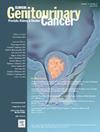整合基因组分类器和非可疑磁共振成像结果在局部前列腺癌患者淋巴结转移预测模型中的应用
IF 2.7
3区 医学
Q3 ONCOLOGY
引用次数: 0
摘要
目的建立和验证根治性前列腺切除术男性伴/不伴可疑磁共振成像(MRI)伴/不伴基因组分类器(GC)的淋巴结累及(LNI)预测模型。方法回顾性分析机器人辅助根治性前列腺切除术(RARP)中行扩展盆腔淋巴结切除术(ePLND)的患者。ePLND定义为切除闭孔、髂内外及髂总淋巴结远端。根据术前检查、影像学检查和GC检查,我们将患者分为三组。队列I有可疑MRI (n = 2172),队列II无可疑MRI (n = 1233),队列III有GC,无论MRI结果如何(n = 1003)。进行逻辑回归分析,建立预测LNI的nomogram。采用受试者工作特征(ROC)和决策曲线分析(DCA)评估净收益。采用r4.3.3进行统计学分析。并利用人工神经网络(ANN)对LNI风险进行二元分类计算。结果1、2、3组共138例(6.4%)、49例(3.9%)、69例(6.8%)发生LNI。多变量分析显示,前列腺特异性抗原(PSA)、活检Gleason分级组(GGG)、阳性核数、MRI LNI是所有队列中LNI的显著预测因子;MRI病变大小、MRI T分期(队列I)、MRI前列腺体积(队列II)和活检GC(队列III)均有显著性差异。队列I、II和III预测LNI的ROC分别为0.92、0.84和0.91。使用人工神经网络,我们计算出队列I、II和III的ROC曲线分别为0.90、0.82和0.91。DCA对每个队列的淋巴结转移模型检测显示出临床益处。结论我们开发了一种综合临床、放射学、组织学和基因组参数的nomogram前列腺切除术中淋巴结转移的预测方法。这将避免不必要的淋巴结切除术,代价是失去少数转移灶。本文章由计算机程序翻译,如有差异,请以英文原文为准。
Integrating Genomic Classifiers and Nonsuspicious Magnetic Resonance Imaging Findings in Predictive Modelling for Lymph Node Metastasis in Patients With Localized Prostate Cancer
Objectives
To develop and validate model predicting lymph node involvement(LNI) in men undergoing radical prostatectomy with/without suspicious magnetic resonance imaging(MRI) with/without genomic classifiers (GC).
Methods
Retrospective analysis of patients that underwent extended pelvic lymphadenectomy(ePLND) during robot-assisted radical prostatectomy(RARP). ePLND was defined as removal of obturator, internal and external iliac and distal part of common iliac lymph nodes. Based on preoperative work-up, imaging, and GC testing, we stratified patients into three cohorts. Cohort I with suspicious MRI (n = 2172), cohort II with nonsuspicious MRI (n = 1233) and cohort III with GC irrespective of MRI findings (n = 1003). Logistic regression analysis performed to create nomogram for predicting LNI. Receiver operative characteristics (ROC) and decision curve analysis (DCA) were performed to evaluate net benefit. Statistical analyses were performed using R 4.3.3. We also utilized artificial neural network (ANN) for calculating LNI risk by using binary classification model.
Results
Overall 138 (6.4%), 49 (3.9%) and 69 (6.8%) patients had LNI in cohort I,II and III respectively. Multivariable analysis showed prostate specific antigen (PSA), biopsy Gleason Grade Group (GGG), number of positive cores, MRI LNI were significant predictors of LNI in all cohorts; MRI lesion size, MRI T stage (cohort I), MRI prostate volume (cohort II) and biopsy GC (cohort III) were significant. ROC for predicting LNI were 0.92, 0.84 and 0.91 for cohort I,II and III respectively. Using the ANN, we calculated ROC curves were 0.90,0.82 and 0.91 for cohort I, II and III, respectively. DCA showed a clinical benefit for the model detection of LN metastases for each cohort.
Conclusions
We developed the nomogram that integrate clinical, radiological, histological and genomic parameters to predict lymph node metastases during prostatectomy. This will avoid unnecessary lymphadenectomy at cost of missing of few metastases.
求助全文
通过发布文献求助,成功后即可免费获取论文全文。
去求助
来源期刊

Clinical genitourinary cancer
医学-泌尿学与肾脏学
CiteScore
5.20
自引率
6.20%
发文量
201
审稿时长
54 days
期刊介绍:
Clinical Genitourinary Cancer is a peer-reviewed journal that publishes original articles describing various aspects of clinical and translational research in genitourinary cancers. Clinical Genitourinary Cancer is devoted to articles on detection, diagnosis, prevention, and treatment of genitourinary cancers. The main emphasis is on recent scientific developments in all areas related to genitourinary malignancies. Specific areas of interest include clinical research and mechanistic approaches; drug sensitivity and resistance; gene and antisense therapy; pathology, markers, and prognostic indicators; chemoprevention strategies; multimodality therapy; and integration of various approaches.
 求助内容:
求助内容: 应助结果提醒方式:
应助结果提醒方式:


